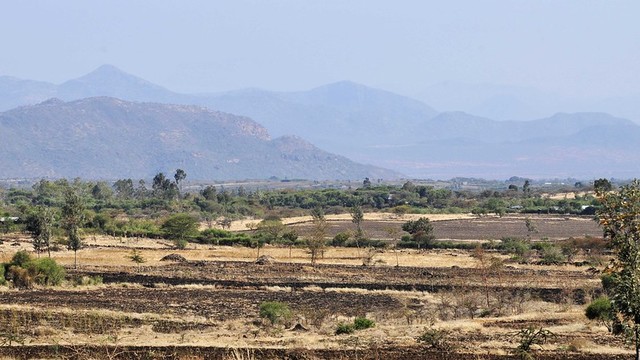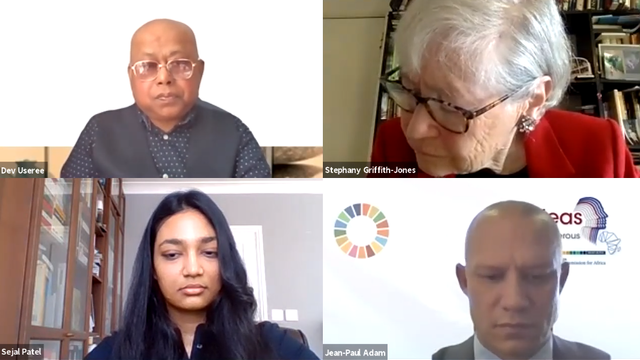Going 'mobile first' to reach African audiences
Mobile means more than being on the move, it means connecting to the next generation of African audiences.



Mobile devices enable people to access a wide range of resources: in Kampala Jane Zamukunda got free legal advice from Barefoot Law via her phone (Photo: King Baudouin African Development Prize, Creative Commons via Flickr)
Recent data shows that 52% of the world’s website traffic is now coming from mobile devices (mobile phones and tablets), but this is not reflected in IIED’s website analytics – we still see 70% of our visitors accessing our online content via desktops and laptop computers.
Is this because we don’t know enough about how people in developing countries are getting online, or because accessing content via a mobile device is so different? How can IIED and partners present content in a way that works better for mobile audiences and what should IIED prioritise to reach these people? Questions that need answering when we think about how to develop our website and engage audiences in the future.
IIED commissioned Cheryl Brown to do audience research in five African countries, reviewing recent research findings and interviewing experts to discover what the situation is in Kenya, Senegal, Tanzania, South Africa and Ethiopia. Here are some of her observations:
As you might expect, I spotted clear differences between countries and types of people in terms of which communications approaches would work best for them. There’s no getting away from the fact, for example, that if you really want to be read widely in Senegal, you need to be writing in French. Other factors which need to be considered are the rural/urban divide, the gender divide and differing costs of accessing mobile data.
But one common theme wherever I looked was the sharp increase in people who use mobile devices to access the internet. In Kenya and Senegal more than 26% of people have a mobile broadband subscription (PDF); in South Africa, it’s more than 58% – higher than the world average of 52.2%.
For some people, using a mobile device may be the most reliable way for them to access the internet, for example in Tanzania, where fixed line internet access is unreliable.
Students – of course – are leading the way in using mobiles; I’m still getting over the story one interviewee told me of a development studies student who wrote their whole dissertation using their mobile!
A recent study on mobile applications in university education in Kenya found that mobile phone ownership by students was greater than US students, that about half of the students surveyed use mobile applications to download research publications and over a third would like to use their mobile to access their university’s e-library.
Some students are getting frustrated with visiting websites or reading digital publications that aren’t designed to be read on mobile devices. Try reading a 30-page PDF research report on a smartphone and you’ll see why.
It’s not just students – in the health sector at least, many South African policymakers said they had smartphones and were considering social networks or email as a possibility for knowledge exchange activities (although they’re not allowed to use social media at work).
In some countries, mobile data charges are expensive (Ethiopia is one of the most expensive in the world, for example) so people will appreciate it if your webpages and other online content are optimised for speedy loading on mobile devices (say goodbye to those big cover photos). Audiences won’t hang around wherever they are in the world, if content takes too much time or too much money to access it.
Understanding the communications landscape
IIED is not in the business of simply battling to get users' attention while they use their mobile phones. This is about understanding our audiences’ information needs and improving their experience, so users don’t have to work unnecessarily hard to find what they are looking for.
The growth of ‘mobile first’ audiences across Africa is just one aspect of a rapidly changing communications landscape across the global South. It is exciting – and also challenging – to try to meet the information needs of users who are using mobile devices, new applications and a range of social media to access our material. In-country research and conversations with our partners can help keep us in touch – and we know that paying attention to changes in communications preferences pays off.
In the summer of 2016, IIED re-designed its Publications Library, investing in mobile responsive development. Over the following 12 months IIED saw big increases in website traffic from mobile devices in four of the countries where we undertook this research. For example, after our site update visits from Tanzania increased by 53%. We have also seen a 50% increase in publication downloads globally among key audiences.
We know that people use mobile devices differently from desktop machines, developing more intimate relationships with them in all aspects of their lives. People are becoming more dependent on them, wanting to be able to get everything from them, rather than chop and change between different devices.
A smartphone can also give users almost instant access to audio, video, and social networks and private communities to share information. With over 2.95 billion active mobile social media users globally in January 2017, the opportunities for IIED to create social media content via these networks, as well as one-to-one via our experts, are endless.
A range of IIED experts will be at #COP23, inc @andynortondev, @AchalaC & @SaleemulHuq. See the full list & follow: https://t.co/QEMsqJRgIt pic.twitter.com/xYjMJNX2cI
— IIED (@IIED) November 3, 2017
The future lies in the palm of your hand
All of this changes the way that IIED communicates research. We have learned of some in-country implications for mobile access such as the cost of internet access, freedom of information, broadband speed and gender gaps. But ultimately our goal is to design websites that are fully accessible and easy to use on any device: providing content that can be consumed effectively in the palm of your hand.
We will continue to explore offering HTML versions of PDF research reports, raising the profile of IIED’s experts on social media and research networks, thinking 'mobile first' where our audiences need it and creating more visual and audio content. This kind of digital development doesn’t hurt your desktop digital offering, it should improve it.
And it’s safe to make the assumption that people may be reading, watching or listening via their mobile phones or tablets, because that’s what the next billion people to access the internet will be using.



